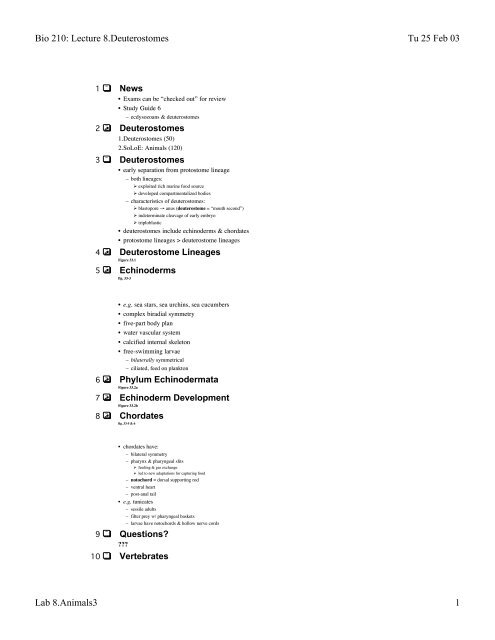Bio 210: Lecture 8.Deuterostomes Tu 25 Feb 03 Lab 8.Animals3 1
Bio 210: Lecture 8.Deuterostomes Tu 25 Feb 03 Lab 8.Animals3 1 Bio 210: Lecture 8.Deuterostomes Tu 25 Feb 03 Lab 8.Animals3 1
Bio 210: Lecture 8.Deuterostomes Tu 25 Feb 031 News• Exams can be “checked out” for review• Study Guide 6– ecdysozoans & deuterostomes2 Deuterostomes1.Deuterostomes(50)2.SoLoESoLoE: : Animals (120)3 Deuterostomes• early separation from protostome lineage– both lineages:‣ exploited rich marine food source‣ developed compartmentalized bodies– characteristics of deuterostomes:‣ blastopore Æ anus (deuterostome(= “mouth second”)‣ indeterminate cleavage of early embryo‣ triploblastic• deuterostomes include echinoderms & chordates• protostome lineages > deuterostome lineages4 Deuterostome LineagesFigure 33.15 Echinodermsfig. 33-3• e.g. sea stars, sea urchins, sea cucumbers• complex biradial symmetry• five-part body plan• water vascular system• calcified internal skeleton• free-swimming larvae– bilaterally symmetrical– ciliated, feed on plankton6 Phylum EchinodermataFigure 33.2a7 Echinoderm DevelopmentFigure 33.2b8 Chordatesfig. 33-5 & 6• chordates have:– bilateral symmetry– pharynx & pharyngeal slits‣ feeding & gas exchange‣ led to new adaptations for capturing food– notochord = dorsal supporting rod– ventral heart– post-anal tail• e.g. tunicates– sessile adults– filter prey w/ pharyngeal baskets– larvae have notochords & hollow nerve cords9 Questions????10 VertebratesLab 8.Animals3 1
- Page 2 and 3: Bio 210: Lecture 8.Deuterostomes Tu
- Page 4: Bio 210: Lecture 8.Deuterostomes Tu
<strong>Bio</strong> <strong>210</strong>: <strong>Lecture</strong> <strong>8.Deuterostomes</strong> <strong>Tu</strong> <strong>25</strong> <strong>Feb</strong> <strong>03</strong>1 News• Exams can be “checked out” for review• Study Guide 6– ecdysozoans & deuterostomes2 Deuterostomes1.Deuterostomes(50)2.SoLoESoLoE: : Animals (120)3 Deuterostomes• early separation from protostome lineage– both lineages:‣ exploited rich marine food source‣ developed compartmentalized bodies– characteristics of deuterostomes:‣ blastopore Æ anus (deuterostome(= “mouth second”)‣ indeterminate cleavage of early embryo‣ triploblastic• deuterostomes include echinoderms & chordates• protostome lineages > deuterostome lineages4 Deuterostome LineagesFigure 33.15 Echinodermsfig. 33-3• e.g. sea stars, sea urchins, sea cucumbers• complex biradial symmetry• five-part body plan• water vascular system• calcified internal skeleton• free-swimming larvae– bilaterally symmetrical– ciliated, feed on plankton6 Phylum EchinodermataFigure 33.2a7 Echinoderm DevelopmentFigure 33.2b8 Chordatesfig. 33-5 & 6• chordates have:– bilateral symmetry– pharynx & pharyngeal slits‣ feeding & gas exchange‣ led to new adaptations for capturing food– notochord = dorsal supporting rod– ventral heart– post-anal tail• e.g. tunicates– sessile adults– filter prey w/ pharyngeal baskets– larvae have notochords & hollow nerve cords9 Questions????10 Vertebrates<strong>Lab</strong> <strong>8.Animals3</strong> 1
<strong>Bio</strong> <strong>210</strong>: <strong>Lecture</strong> <strong>8.Deuterostomes</strong> <strong>Tu</strong> <strong>25</strong> <strong>Feb</strong> <strong>03</strong>• vertebral column• jointed, rigid endoskeletons• two pairs of appendages• anterior skull w/ large brain• large coelom• well-developed circulatory system11 Vertebrate Classes• Subphylum Vertebrata includes five classes:1. Osteicthyes ~ bony fishes2. Amphibia ~ amphibians3. Reptilia ~ reptiles4. Aves ~ birds5. Mammalia ~ mammals12 Vertebrate AnatomyFigure 33.713 Jaws, Legs & Lungsfig. 33-12• fish jaws evolved from anterior gill arches– for grasping & chewing prey• unjointed fins control swimming movements• lunglike sacs– supplemented gas exchange @ gills– swim bladders for buoyancy• bony fishes are diverse in size, shape & behavior14 Jawed FishesFigs 33.9-1115 From Water to Land• lobe-fins & lungfishes evolved jointed fins• led to amphibians, first vert’s to colonize land– via fresh water– protostomes colonized land via beaches• tetrapod = four-legged terrestrial vertebrates16 Amphibiansfig. 33-15• amphibians spend much of life in water• eggs must remain moist• 4,500 amphibian species alive today• three orders:– caecilians– anurans = frogs & toads– urodelans = salamanders17 Amphibian Eggs Need MoistureFigure 33.161819 Questions????20 Amniotes<strong>Lab</strong> <strong>8.Animals3</strong> 2
<strong>Bio</strong> <strong>210</strong>: <strong>Lecture</strong> <strong>8.Deuterostomes</strong> <strong>Tu</strong> <strong>25</strong> <strong>Feb</strong> <strong>03</strong>• amniotes lay eggs protected by water-resistant shells & membranes, incubate them externally• reproduction not dependent on water• reptiles were first amniotes• modern reptiles include four lineages– turtles & tortoises– tuataras– snakes & lizards– crocodilians21 AmniotesFigure 33.1722 Reptile OriginsFigure 33.1823 Birds: Feathers & Flightstock photo24 Birdsfig. 33-21• amniotes• controversial origins ~175 mya• 9,600 extant species– feathers, wings, tail & wishbone– high metabolic rates– parental care– larger brains<strong>25</strong> Mammalian Origins & Diversityfig. 33-22b• mammals evolved ~2<strong>25</strong> mya• eggs fertilized w/in females• embryos develop in utero• only mammals suckle young• Prototherians lay eggs– e.g. platypus, anteaters• two major groups of Therian mammals:– marsupials give birth to tiny young– eutherians bear well-developed young26 Marsupials & Eutheriansfig. 33-23 & 2427 ICE 8.1: Vertebrate Succession• Over time, reptiles replaced amphibians as the Earth’s s dominant terrestrial vertebrates. Why might this havehappened?• Later, when dinosaurs became extinct, mammals replaced reptiles as the Earth’s s dominant terrestrial vertebrates.Again, why?28 Primates & Human Origins• primates became adapted for arboreal life– opposable thumbs– nails rather than claws– forward eyes for binocular vision– small litters• split into two lineages:– prosimian includes lemurs, lorises & pottos– anthropoid includes tarsiers, monkeys, apes & humans<strong>Lab</strong> <strong>8.Animals3</strong> 3
<strong>Bio</strong> <strong>210</strong>: <strong>Lecture</strong> <strong>8.Deuterostomes</strong> <strong>Tu</strong> <strong>25</strong> <strong>Feb</strong> <strong>03</strong>• hominids evolved in Africa from bipedal ancestors– left the trees– elevated eyes, freed hands for tool use29 PrimatesFigure 33.<strong>25</strong>30 Homo sapiensfig. 56-9a• large brains• complex societies• language• culture– tools– rituals– agriculture– domesticated plants & animals31 Primates & Human OriginsFigure 33.3<strong>03</strong>2 Human Population GrowthHumans have experienced three population surges:1.tools2.agriculture3.industryThe current surge is still in progress, but leveling off. What next?33 Human Population GrowthFigure 33.3234 ICE 8.2: IntelligenceAs we study more complex animals, we encounter more complex nervous systems and, ultimately, intelligence.Plants do not have nervous systems, but:• they respond to environmental stimuli.• they defend themselves, sometimes aggressively.Are plants intelligent? Or do animals alone claim this characteristic?35 Survey of Life on EarthAnimals• Octopus dolfleini• Limax sp.• Asteroides sp.• Amphioxus sp.• Salmo salar• Anolis carolinensis• Gallus gallus• Homo sapiens36 See You Thursday!• Ch 28 & 29, Plants• SoLoE: : Plants<strong>Lab</strong> <strong>8.Animals3</strong> 4



